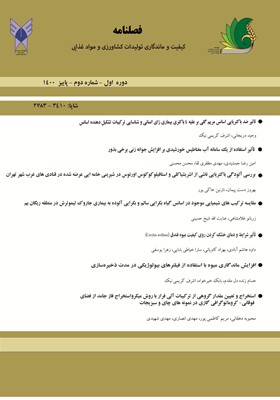بررسی آلودگی باکتریایی ناشی از اشرشیا کلی و استافیلوکوکوس اورئوس در شیرینی خامه ایی عرضه شده در قنادیهای غرب شهر تهران
محورهای موضوعی : ماندگاری فراورده های غذایی و تولیدات کشاورزینازنین خاکی پور 1 * , بهروز دست پیمان 2
1 - استادیار، گروه کشاورزی، واحد سوادکوه، دانشگاه آزاد اسلامی، سوادکوه، ایران
2 - کارشناسی ارشد، گروه علوم و صنایع غذایی، واحد سوادکوه، دانشگاه آزاد اسلامی، سوادکوه، ایران
کلید واژه: آلودگی باکتریایی, شیرینی خامه ای, اشرشیاکلی, استافیلوکوکوس اورئوس,
چکیده مقاله :
این مطالعه به صورت توصیفی - مقطعی با هدف بررسی وجود یا عدم وجود آلودگی باکتریایی ناشی از باکتری اشرشیاکلی و باکتری استافیلوکوکوس اورئوس در شیرینی خامه ای در غرب شهر تهران انجام شد. از12 قنادی منتخب در غرب تهران، معادل 3 عدد (نمونه غذایی جامد) با استفاده از روش نمونه برداری تصادفی ساده تهیه شد. جهت جداسازی و شناسایی باکتری اشرشیاکلی از محیط کشت لوریل سولفات تریپتاز استفاده شد، با توجه به تولید گاز و مشاهده کدورت در تمامی نمونه (36 نمونه)، از محیط کشت انتخابیEC جهت مرحله تکمیلی و تاییدی استفاده شد (36 نمونه) و در آخر از محیط کشت آب پپتونه جهت آزمون های تاییدی باکتری اشرشیاکلی و تمایز از سایر کلی فرمهای مدفوعی، از معرف کواکس جهت تایید نهایی استفاده شد. جداسازی و شناسایی باکتری استافیلوکوکوس اورئوس با استفاده از محیط کشت غنی کننده صورت گرفت و با توجه به تولید پرگنه هایی کروی یا بیضی و یا دوکی شکل که در عمق محیط در تمامی نمونه ها ایجاد شد، از محیط کشت Baird Parker Agar به عنوان پایه جهت مرحله دوم استفاده شد و درادامه آزمون کواگولاز جهت تایید باکتری استافیلو کوکوس اورئوس از سایر استافیلوککها، از پلاسمای سیتراته خرگوش جهت آزمونهای تاییدی استفاده شد. با بررسی داده ها، میزان آلودگی باکتریایی ناشی از باکتری استافیلوکوکوس اورئوس در 36 نمونه برابر با 25% و میزان آلودگی باکتریایی ناشی از باکتری اشرشیا کلی در 36 نمونه برابر با 5% گزارش شد.
This descriptive cross-sectional study was performed to investigate the presence or absence of bacterial contamination caused by Escherichia coli and Staphylococcus aureus in creamy sweets in the west of Tehran. From 12 selected confectioneries in the west of Tehran, about 500 grams of creamy sweets equivalent to 3 pieces (solid food sample) (according to the instructions of the standard number of samples required in food sampling) were prepared using simple random sampling method. In this study, in order to isolate and identify Escherichia coli bacteria, lauryl sulfate tryptase culture medium was used. Due to gas production and turbidity observed in all samples (36 samples), EC Broth selective culture medium was used for complementary and confirmatory steps. peptone water culture medium was used for confirmatory tests of Escherichia coli and differentiation from other fecal coliforms, coaxial reagent was used for final confirmation. Isolation of Staphylococcus aureus bacteria was done using Cooked Meat enrichment medium and due to the production of spherical or oval or spindle colonies that were created in the depth of the medium in all samples, from Baird Parker Agar culture as The base was used for the second stage and in continuation of coagulase test to confirm Staphylococcus aureus bacteria from other staphylococci, rabbit citrate plasma was used for confirmatory tests. By reviewing the data, the rate of bacterial contamination caused by Staphylococcus aureus in 36 samples was equal to 25% and the rate of bacterial contamination due to Escherichia coli in 36 samples was equal to 5%.
1- Smith J P, Daifas D P, EL-Koukoutsis J, EL-Khoury A. Shelf life and safety con-cerns of bakery products-Areview. Critical reviews in food science and nutrition. 2004;44:19-55.
2- Rezaei R, Sadeghi M, Ghasemian Sa-faee H, Mirloohi M, Hassanzadeh A. Fre-quency distributions of Escherichia coli in the confectionery products offered in retail market in Isfahan. Biological Journal of Microorganism. 2016;5(17):27-34.
3- Salehzadeh H, Rezaee R, Mozafari P, Mohammadi S H, Rezaee H. Investigation of bacterial contamination level of raw sweets in Sanandaj city in 2018. Journal of student research center (Beyhagh). 2018; 23(1): 41-49. [In Persian]
4- Masoomali Nejad Z, Zinatizadeh M R, Meybodi S M, Zarei F. Isolation of mic-robial contamination of sweets in Sirjan city. Journal of Preventive Medicine. 2017;4(1):56-62. [In Persian]
5- National Standard Organization of Iran. Second revision, Standard No: 2395. Mic-robiology Confectionery and confectionery products, features and methods Test. 2018. [In Persian]
6- Rezweiler W. Pathogenic microbes in food and the epidemiology of food pois-oning. Printing Fourth, Tehran University Press. 2016. [In Persian]
7- Hosseini Jazani N, Babazadeh H. Dete-rmination The Rate of Methicillin Resist-ant and Enterotoxigenic Staphylococcus aureus in Different Kinds of Creamy Pastries Sold in Some Of Pastry Shops In Urmia. Studies in Medical Sciences. 2013; 24 (1):45-51.
8- National Standard of Iran. No: 2946. Third Edition-First revision of the method of search and counting the highest possible number of Escherichia coli bacteria in food. 1995. [In Persian]
9- National Standard of Iran. No: 6806. Microbiology of animal feed-Counting and identification of coagulase staphylococci. 2003. [In Persian]
10- Machado T F, Pereira R, Nogueira N A, De Sousa C T, Batista V, Atividade. 2012. Antimicrobiana Do Óleo Essencial De Manjericão Contra Patógenos E Dete-rioradores De Alimentos. Embrapa Agro-indústria Tropical-Boletim De Pesquisa E Desenvolvimento (INFOTECA-E).
11- Shabani Sh, Sadeghi Mahoonak Ar, Jalali H. Microbial Contamination of Pa-stry Cream Supplied in Gorgan. Medical Laboratory Journal. 2014;8(2):62-66. [In Persian]
12- Dehdari L, Hajizadeh M. 2014. A study of the level of contamination of creamy sweets in confectioneries of Ka-zerun city. National conference on snacks. [In Persian]
13- Haghparast H, Rezaei R, Sadeghi M. Investigation of the status of some micr-oorganisms of food poisoning and spoilage in sweets-Offers in Isfahan. Journal of Isfahan Medical School.1395;34(378):367-380. [In Persian]
14- Nasehinia H, Rahimi Pardanjani S, Kiani M, Ghanepour M R, Shahsvand M, Ajam F. Evaluation of microbial conta-mination of sweets Traditional of Yazd in 2015. Research Journal Community He-alth. 2017;2(4):26-34. [In Persian]
15- Ajdari A, Hashem Zehi N. Microbial quality evaluation of dry sweets offered in Birjand. Journal of Food Microbiology. 1399;3:22-13.
_||_
